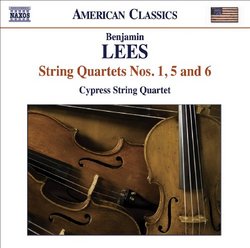Tuneful, energetic works from an unjustly neglected composer
Matthew Wilcox | Lansing, MI | 08/23/2009
(5 out of 5 stars)
"Lees is an American composer whose greatest recognition has been in his later years in life. He achieved fame in his youth as well, winning the very first Fromm Foundation Award in 1952, and having his String Quartet No. 1 performed by the Juilliard String Quartet a couple of years later.
The Cypress String Quartet commissioned Lees' No. 5 quartet as part of a series called "Call & Response". They asked Lees to answer to the quartets of Shostakovich and Britten, and his response, composed in 2001, is one of the 101 great ensemble works (according to Chamber Music America).
The composer's voice is no less apparent in his String Quartet No. 6. The piece is quick and forceful, and leaves a lasting impression. This was also written for the Cypress, and was completed in 2005. All three works are tuneful, yet there is a vast difference in style between his first and later quartets. The Cypress String Quartet play these pieces intelligently, and with a lot of color."
Three Wonderful Quartets by an Underrecognized Master
J Scott Morrison | Middlebury VT, USA | 08/15/2009
(5 out of 5 stars)
"Benjamin Lees (b. 1924) is one of America's (and the world's) most treasurable composers. And he's still writing music, the last I heard. He was born in Harbin, China (the son of Russian emigrants named Lysniansky) and was brought by them to the US as a baby where he grew up in California. He studied at USC under Ingolf Dahl and Halsey Stevens. And he studied privately with the former 'bad boy of music', George Antheil, to whom he gives great credit for his development as a composer. His music is uncommonly ingratiating, modern but not in your face about it. If I had to describe his music in one word it would be that it is 'alive'. Every moment seems to have something to command your rapt attention, whether it be melodic interest, harmonic invention or unexpected rhythms. In one of his quotable phrases Nicolas Slonimsky describes Lees' music as having 'euphonious dissonances.' Quite so.
The three quartets recorded here, although separated by fifty years (1st, 1952; 5th, 2001; 6th, 2005), are clearly in Lees unmistakable voice. The 1st is in three movements - moderato, slow, fast - and is neoclassical in form. The first movement is a modified sonata-allegro with two themes, development, recapitulation. The second is lyrical, mostly quiet. The third is a rondo with three subjects, two lively, one cantabile; it has a brief vigorous coda.
Quartet No. 5 is in four movmeents. Its first movement is stentorian and marked 'measured'. It incorporates continuous development of three themes. The second movement, marked 'Arioso', opens with a conversational duet between the two violins rather like a shared recitative. The movement is primarily lyrical but there are interruptions from the cello marked 'menacing'. These lose force and the two violins resume their dialog in the instruments' highest register, rather like birds soaring into the blue. The short third movement is marked 'quick, quiet'. In their booklet notes the Cypress Quartet describe the movement as ending in 'a puff of smoke.' The fourth movement is marked 'explosive' and after an agitated introduction becomes a frenzied quasi-fugue. There are brief islands of respite but the movement comes to a forceful close.
Quartet No. 6 was written for the Cypress Quartet and premièred in 2005. The first movement opens with a menacing tone but a lyrical subject appears out of the blue. These moods alternate and the movement ends with uneasy figures supplanted at the end by serenity. The second movement, marked 'calm, steady', begins with slow, quiet, hymn-like chords. A cello figure is developed contrapuntally and eventually the opening mood returns. The third movement, marked 'quiet, eerie', is short -- about 2 1/2 minutes -- and makes much use of diffident pizzicato notes in the upper strings. There is a churning forte passage before falling back into a pianissimo close with all four players playing pizzicato. The fourth movement has sardonic elements mixed with the calm, lyrical cello theme. The sassy tongue-in-cheek passages lead to a driving mood that gathers momentum until the final page which is marked 'as fast as possible.' The quartet ends breathlessly triumphant.
These three quartets are easily qualified for a place in the quartet repertoire. They are given marvelous performances by the San Francisco-based Cypress Quartet.
An easy recommendation.
Scott Morrison
"

